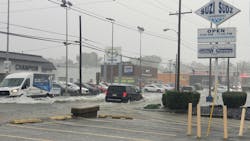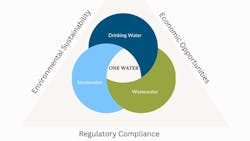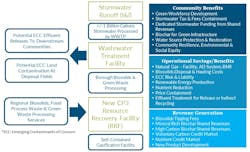Transforming waste into green solutions: Leveraging a community-based public-private partnership (CBP3) to fund green infrastructure
Nationwide, many communities face increasing regulations for stormwater management (NPDES/MS4) and emerging contaminants like PFAS, endocrines, pharmaceuticals and microplastics. In April 2024, the U.S. Environmetal Protection Agency (EPA) finalized PFAS drinking water maximum contaminant levels (MCLs)[1] and proposed interim guidance on PFAS destruction and disposal[2]. These regulations create complex requirements and significant financial burdens, particularly for older communities with aging infrastructure, and can be devastating for disadvantaged communities due to underinvestment (Environmental Justice (EJ)[3]).
Innovative solutions in Hanover, Pennsylvania
In Hanover, located in western York County, Pennsylvania, addressing water, wastewater, and stormwater infrastructure issues amid financial and regulatory challenges led to innovative solutions. These include transitioning to a “One Water Hanover” structure, converting the wastewater treatment plant (WWTP) into a Resource Recovery Facility (RRF) using a Circular Resource Management (CRM) strategy through a community-based Private-Public Partnership (CBP3).
Hanover’s struggles mirror those of many communities as rebuilding stormwater infrastructure exceeds the capacity of its tax and fee base. Established in 1815, Hanover has nearly 17,000 residents and faces stagnant tax revenue growth due to its built-out municipal area, further burdening its citizens. Located in the Chesapeake Bay[4] watershed, Hanover is under pressure from federal and state authorities regarding water quantity and quality management, especially concerning its 58% untreated impervious area and the WWTP.
Despite pioneering one of Pennsylvania’s first stormwater authorities (SWA), Hanover faces inadequate fee revenues to support stormwater infrastructure improvements. External funding sources like grants are limited and competitive, often requiring financial matching. While State Revolving Funds (SRF)are available, securing reliable funding for debt repayment is crucial. The proposed CBP3 approach would allow Hanover to access low-interest SRF funds for the RRF and use its revenues to fund green infrastructure through a 20-year low-interest loan. If PFAS are present in WWTP effluent or biosolids, EPA PFAS grant funding could help reduce overall debt. As an EJ community, Hanover might benefit from debt-to-grant conversions or interest rate reductions.
Meeting Hanover’s NPDES/MS4 permit requirements is challenging due to high imperviousness and stormwater infiltration and intrusion (I&I), which heighten risks at the WWTP during significant storm events. The WWTP, with a hydraulic capacity of 7.3 million gallons per day (MGD) and a standard operating capacity of 4 MGD, experiences flow spikes of 15 to 20 MGD during major storms. For example, an early April 2024 storm led to flow increases between 13.7 MGD and 17.5 MGD, over a three-day period, exceeding the allowable nitrogen limits. The WWTP processes more than 1 billion gallons annually from stormwater intrusion alone, highlighting the challenge. The proposed $24 million downtown green streets streetscape project addresses only a fraction of the Borough-wide stormwater issues.
Navigating municipal governance laws requires working within tight restrictions to discover innovative solutions while mitigating risks. Maintaining a focus on innovation, even outside established norms, is crucial. This transformation demands collaboration across municipal, technical, regulatory, financial and legal teams. Since regulations vary by state, having a strong legal team that understands the issues and can collaborate with the team to reimagine challenges as opportunities for growth and revenue is essential.
Coordinating the project team is often the simplest hurdle. The greater challenge is gaining support from stakeholders, including elected officials, the stormwater authority board, and citizens. This requires extensive dialogue, education and site visits. The Borough council and SWA commissioners must understand the technical details to back the initiatives.
In 2020, Hanover began a transformative water management journey, recognizing the interconnectedness of drinking water, wastewater and stormwater. As water policies progressed towards greater integration, the Borough transitioned from siloed departmental management to a unified structure. The initial focus was on establishing centralized management, aiming to realize the “One Water Hanover” program. This initiative promotes sustainability through environmentally sound, economically viable, and socially equitable water management practices.
One Water Hanover program
The CBP3 acknowledges that each community’s objectives and needs vary. In 2023, Hanover began establishing a CBP3, transforming challenges into opportunities through a CRM approach. This ensures each element serves multiple purposes, with outputs from one process feeding into another. This circular economy model addresses resource scarcity, environmental degradation and climate change. By implementing CBP3, Hanover is tackling multiple issues while offering cost offsets and revenue-sharing mechanisms to meet the community’s stormwater needs.
In collaboration with Earthcare Solutions, LLC, Hanover will transform the WWTP into an RRF, incorporating wood/green waste, organics and biosolids management. The CRM strategy promotes sustainable practices to optimize resource efficiency and minimize environmental impacts. A key component of the RRF is BIOCHAR[5], a charcoal-like material that converts diverse biomass waste into a carbon negative resource for green infrastructure, water filtration, soil restoration and remediation. This integration underscores Hanover’s commitment to a circular bioeconomy, making its CBP3 a model for sustainable development.
To streamline decision-making, the Borough council delegated CBP3 management to the Hanover SWA, necessitating changes to the SWA’s Articles of Incorporation. These changes grant SWA authority over facilities for removing, treating, processing, transporting or storing various biomass wastes within its jurisdiction. When developing innovative approaches, it is crucial to anticipate regulatory challenges and expect to spend considerable time educating regulatory agencies. The envisioned facility may not fit existing permitting structures and protocols. Environmental regulations often lack flexibility to accommodate solutions like CRM, being entrenched in systems that reinforce departmental silos and hinder the integration of resource-efficient and sustainable approaches.
In Pennsylvania, determining the lead agency and project classification is challenging. The Department of Environmental Protection (DEP) classifies municipal sewage sludge and biosolids as “municipal waste.” Depending on processing methods and the origin of solid wastes, the facility may fall under different DEP jurisdictions, complicating permitting. Even if biosolids are transformed into biochar, regulators may still classify and regulate their use as biosolids, despite laboratory analysis showing otherwise. CRM initiatives face regulatory barriers as existing regulations are not designed for integrated approaches, highlighting the need for regulatory updates to allow for more flexibility and align with circular economy principles and increase budgetary efficiency.
Facing aging infrastructure and limited stormwater funding, Hanover, an EJ community, is exploring new solutions through the CBP3 initiative. The Borough anticipates direct and indirect benefits from establishing the RRF, primarily aiming to generate non-tax-based revenue streams via a revenue-sharing model. Adopting the CBP3 allows revenue adjustments to align with inflation and market dynamics. Earthcare Solutions’ revenue share, initially estimated at $500,000 annually, could increase to $1.2 million or more as the facility expands. This 20-year commitment, with renewal options, could benefit from favorable SRF terms or EPA PFAS grants, reducing long-term debt. Shared revenues might cover $8 million to $20 million in SRF loans for green infrastructure projects.
This strategy enables the Borough to accumulate funds from citizen fees in the stormwater authority account, enhancing funding flexibility for matching grants.
Conclusion
In closing, facing stringent regulations and aging infrastructure, Hanover is pioneering transformative water management approaches like the “One Water Hanover” program and CBP3. Hanover is forging innovative pathways to address water challenges while promoting sustainability, economic vitality, and social equity. By integrating CRM with biochar production, Hanover navigates regulatory hurdles and sets a precedent for resilience and progress. With a proactive stance and commitment to innovation, Hanover demonstrates that challenges can become opportunities for sustainable development, enhancing community resilience, reducing costs, and promoting environmental and social equity.
References
- https://www.epa.gov/sdwa/and-polyfluoroalkyl-substances-pfas
- https://www.epa.gov/pfas/interim-guidance-destroying-and-disposing-certain-pfas-and-pfas-containing-materials-are-not
- https://www.whitehouse.gov/environmentaljustice/justice40/
- https://obamawhitehouse.archives.gov/realitycheck/the_press_office/Executive-Order-Chesapeake-Bay-Protection-and-Restoration
- https://biochar-us.org/ and https://biochar-international.org/
About the Author
Charles Hegberg
Based in the Mid-Atlantic area, Charles Hegberg ([email protected]) is a Senior Project Consultant with RES (www.res.us). Additionally, he is an elected official for the Borough of Hanover, PA. Mr. Hegberg is a subject matter expert in circular resource management, biomass, and biochar production, and its use for environmental restoration/remediation benefits. Mr. Hegberg serves as Vice Chair for the U.S. Biochar Initiative.





